 |
 |
This topic explains how to generate an iXBRL report for Group/Consolidated Accounts in Accounts Production.
Preparing Group Accounts in iXBRL format is a similar procedure to Limited Companies.
Where a Parent Company is required to prepare both, individual and Group Accounts (Companies Act 2006, Section 399), it is required to file both of these as part of its online Company Tax Return. However, it is only required to file the Parent Accounts as an iXBRL document, with the relevant tags embedded.
Where the Group Accounts are a separate document these must be attached as a PDF file.
In Accounts Production, the Group Accounts and individual accounts will be part of a single consolidated report. There is currently no requirement by HMRC to tag Group/Consolidated Accounts therefore only information relating to Parent Company Accounts is tagged when producing the iXBRL report.
In this Topic Hide
Step 1 – Identifying Accounts/Groups descriptions that have been amended from the IRIS default
Step 2 – Tagging text within the data screens
Step 3 – Generating the iXBRL Accounts for submission to HMRC
Step 4 – Tagging report items within the Tag Editor
Step 5 – Reviewing the tagged iXBRL Report
Step 6 – Finalising the iXBRL Report
Select the Parent Company from the Client Browser screen.
From the Accounts Production menu, select Reports | Account/Group Descriptions
The following screen displays.
Select the relevant options for each section and click OK.
This report enables users to see which account and group descriptions have been amended in order to change/apply the relevant tag. For example, if a posting has been made to the fixed asset motor vehicles account code but the description has been amended to read ‘Boats’, the tag from motor vehicles may need to be amended to a more suitable tag when sending the accounts to HMRC.
Close the report once the items have been reviewed.

Select the Parent Company from the Client Browser screen.
From the Accounts Production menu, select Edit | Data Screens
Select the relevant section of the report to tag from the Data Screen branches. For example, select Notes to Financial Statements | Other Disclosures | Ultimate Controlling Party
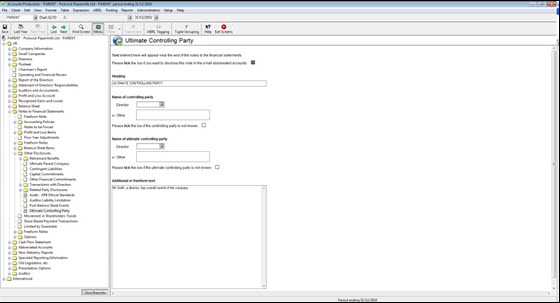
Highlight the text to be tagged.
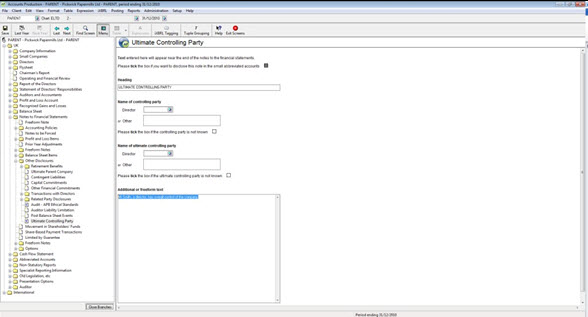
Click the iXBRL
Tagging icon at the top of the menu bar or right-click on the
mouse and select iXBRL tagging.
If no text has been highlighted, selecting the iXBRL Tagging option,
the following warning displays:
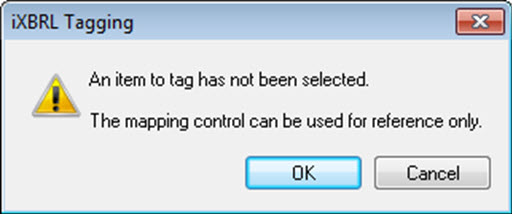
The following screen displays.
Click the magnifying glass next to Concept Label to display the Taxonomy.
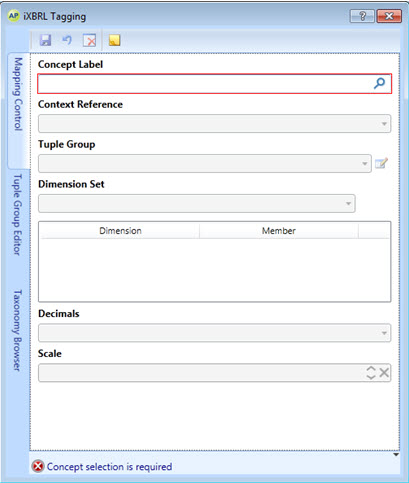
The following screen displays.
Browse the Taxonomy to find the appropriate Concept Label by clicking on the arrow next to the relevant headings to list available concept labels for selection. Alternatively, manually enter text in the search field, for example, controlling party, and press Enter.

Select
the relevant Context Reference
and click Save.

If the selected Concept Label requires a Tuple Group, the following screen displays.
If the selected Concept Label does not require a Tuple Group, go to step 12.

The following screen displays:
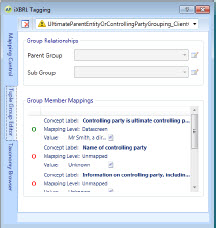

A new Tuple Group will be created and displayed within the Tuple Group field as shown below.

The following screen shows the text which has been tagged within the data screen, highlighted in a purple text box.
Click Save to save changes to the data screens.
Click Exit Screens.

Select the Group Company from the Client Browser screen.
Enter the 3 character mnemonic in the Report/Document field, for example, LTD. (To display a list of available, click in the magnifying glass next to the Report/Document field.)
Confirm the correct posting entries have been selected by default or make your selection in the Current and Last field.
Click OK
to generate the accounts to the Tag Editor.

If exceptions exist within the report for specific details, the following dialog displays.

If warnings exist within the report for specific details, the following dialog displays:

The following screen displays.
The Report – LTD tab displays the report that has been generated with tags applied and/or available to be tagged.

The Exception Report tab displays any mandatory information or discrepancies within the report that must be rectified before the iXBRL report can be finalised.

The Warning Report tab gives details of report items which have not been pre-tagged and may require manual tagging if there is an appropriate concept in the minimum tagging list. See example below:

The iXBRL Warning Report
generated within the Tag Editor relates to the Parent Company only. If
freeform notes have been entered within the data screens, user must manually
tag items if an appropriate concept labels exist within the Minimum Tagging
list.
The iXBRL Preview tab displays the full report in a readable format that will be sent to HMRC – See example below:

Things to consider when tagging your iXBRL accounts:
Concept labels for the totals
cannot be amended (for example, operating profit and profit after
tax).
Pencil icon next to the Notes (on left), indicates that the concept
label of the notes can be amended.
If required, reports can be printed from the iXBRL preview tab, not
from the Reports tab.
Within the Tag Editor screen, click the Report – LTD tab.
From the toolbar, click on the Show Taggable items icon.
Click on the 
 arrow to scroll to the
next page to review tagging.
arrow to scroll to the
next page to review tagging.
Click Show
Taggable Item will show item are pre – tagged by IRIS in BLUE, or hide them if there are
no longer required.



The following screen displays.

The taxonomy is displayed in a presentation view, the tree structure relates to the report structure.
The Mapping Control toolbar also consists of the following icons:
Apply default
![]() - this option reverts the tagged item back to the
IRIS default; this option only applies to pre-tagged items of the report
that have been amended.
- this option reverts the tagged item back to the
IRIS default; this option only applies to pre-tagged items of the report
that have been amended.
Clear mapping
![]() – this option clears mapped tags that have been
applied.
– this option clears mapped tags that have been
applied.
Show/Hide
notes  – this option shows or hides notes.
– this option shows or hides notes.
Next/Back
 - This option allows users to select the next or
previous item to be tagged.
- This option allows users to select the next or
previous item to be tagged.

 Available
Available
 Not available
Not available
If required select the relevant option from the Concept Reference drop-down list.
Click Save.

Click Save.
The following dialog displays.
The Concept label selected may link fields in the Tag Editor; that is, Current year figure to Last year. Therefore if Yes is selected, last year figure will be automatically tagged with concept label selected for current year. If No is selected, users are advised to manually tag the last year figure.

The following items are NOT automatically tagged as HMRC does not require group accounts to be tagged:
Consolidated Profit and Loss Account
Consolidates Statement of Recognised Gains and Losses
Consolidated Balance Sheet
Consolidated Cashflow Statement
Notes to the Cashflow Statement
Notes to the Financial Statement
Information relating to Consolidated Accounts only
Below is an example of a Consolidated Profit and Loss:

Follow step 3 to generate the Tag Editor screen.
Click the Validate
icon from the toolbar.
Upon successful validation, the following message display.

The Validate icon  displays:
displays:
The following screen displays.

Click
Create HMRC Copy.

Save file in IRIS – This
allows the iXBRL account file to be automatically attached when generating
the Electronic CT600 in IRIS Business Tax.
Save externally –
This allows the iXBRL accounts file to be saved in a specific folder.
Click OK.
Click here for a glossary of terms relevant to iXBRL.